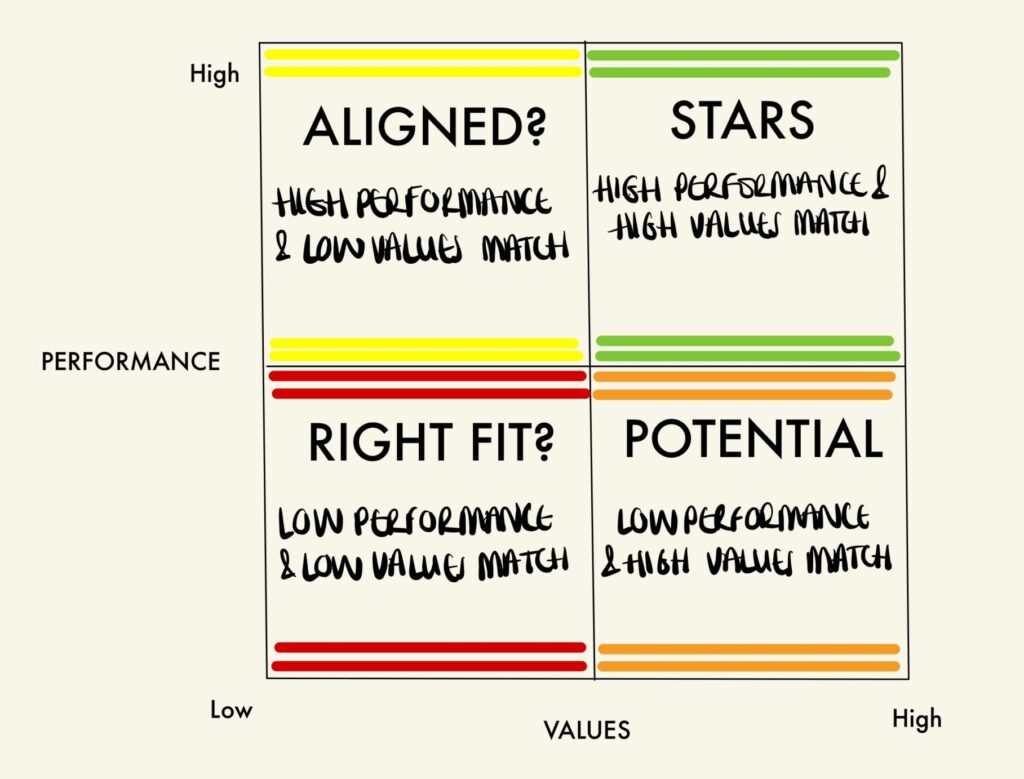Did you know that as coaches we have coaches too?! I have worked with my coach since I completed my ActionCOACH training. Not only does this help me with my own personal development but also with expanding my knowledge.
Recently we were talking about how to effectively coach business owners when they have a team that isn’t performing, and he shared with me the Performance Values Matrix that was developed by Jack Welch. This simple effective model can help you better understand where each team member stands and guide you in making informed decisions about employee development and growth within your business.
I thought I would share with you today how the matrix works and some practical steps to integrate this into your business.
What is The Performance Values Matrix?
Welch’s Performance Values Matrix evaluates employees based on two key dimensions: performance and valuesalignment. Performance assesses an individual’s ability to deliver results, while values alignment measures how well they fit with the company’s culture and core values. By plotting these two axes, you get four quadrants:

- High Performance, High Values
These are your star players. They excel in their role and are a strong fit with the company’s values, setting a positive example for others.
- High Performance, Low Values
These individuals deliver results but don’t necessarily embody the company’s values. They might be skilled in their roles but can sometimes disrupt team culture.
- Low Performance, High Values
These team members align well with company values but may be struggling to meet performance expectations. They often bring positivity to the culture but aren’t contributing to their fullest potential.
- Low Performance, Low Values
This quadrant represents employees who struggle with both performance and values alignment. They neither deliver results nor contribute positively to the company culture.
How do you this to assess and manage your team effectively?
-
Identify Your Star Players (High Performance, High Values)
Your high-performance, high-values employees are invaluable to the business. They’re aligned with your goals, excel in their roles, and are often key drivers of growth. With these employees, your goal should be to nurture and retain them.
You can do this by:
- Providing leadership opportunities. These individuals can inspire others, so consider ways to give them leadership roles or mentorship opportunities within the company.
- Invest in their development. Offer professional development programs or training to help them continue growing, increasing their skills and loyalty.
- Recognise and reward. Recognition for their contributions will reinforce their value alignment and keep them motivated.
-
Addressing Cultural Misalignment (High Performance, Low Values)
Employees who deliver high performance but lack values alignment can present a dilemma. While they contribute positively to business results, they can sometimes clash with team dynamics or disrupt the workplace culture.
To overcome this you can:
- Clarify expectations. It’s crucial to reinforce company values with these individuals, explaining how these values are integral to the business’s long-term success.
- Mentorship or coaching. Provide mentorship to help them better understand and embody the company culture. You can use one of your high-performance, high-values employees to mentor them.
- Monitor for progress. Track how they respond to the mentorship and cultural alignment efforts. If they’re willing to adapt, they can be a strong asset to the team. However, if they consistently resist, you may need to reassess their fit in the organisation.
-
Developing Potential (Low Performance, High Values)
Low-performance, high-values employees often bring a positive attitude and align well with company values, but may need more support to reach full potential. These individuals can become high performers if they are given the right training, guidance, and encouragement.
You can do this by:
- Identifying skills gaps. Work closely with these employees to identify areas where they can improve. What’s holding them back? Is it a lack of resources, training, or experience?
- Providing training and support. Investing in targeted training programs or pairing them with a mentor can help develop their skills and confidence, which can positively impact their performance.
- Setting achievable goals. Start with small, manageable objectives and build toward larger milestones. Giving them room to grow can lead to a steady increase in performance.
-
Managing Underperformance (Low Performance, Low Values)
Employees in this quadrant typically require the most attention, as they neither meet performance expectations nor align with company values. They can be a drain on resources, lowering morale and productivity.
Here’s a few things you can do:
- Assess fit and potential. Determine whether the employee is a fit for any role within the company. Occasionally, poor performance or values misalignment can be resolved with additional training or a role adjustment.
- Offer a clear improvement plan. If there’s potential, give them a well-defined improvement plan, focusing on both skills and cultural alignment. Be upfront about expectations and provide regular feedback on their progress.
- Consider a parting of ways if necessary. If there’s no improvement after the intervention, it may be best for both the employee and the business to part ways.
How the Matrix Helps You as a Business Owner
Incorporating the Performance Values Matrix into your performance reviews or regular assessments can offer several benefits:
- Objective Evaluation. The matrix gives a structured, objective way to evaluate your team, reducing emotional bias and focusing on core areas of performance and cultural fit.
- Clarity in Decision-Making. When you know where each team member stands, decisions about training, promotions, or bringing employment to an end become clearer and easier to justify.
- Alignment with Business Goals. By reinforcing both performance and values, you’re setting a standard for what it takes to thrive in your organisation.
Using this approach empowers you to build a team that not only excels in their roles but also drives a culture that aligns with your business vision. It’s about creating an environment where your team members feel motivated to perform at their best and contribute to a shared purpose.
A successful business team is composed of individuals who perform well individually and, together, contribute to a winning culture. The Performance Values Matrix is a powerful tool that can help you achieve that harmony by keeping performance and values front and centre in your leadership strategy.
By applying the principles of the Performance Values Matrix, you’re not only shaping your team but also strengthening your business’s foundation for growth and success.





